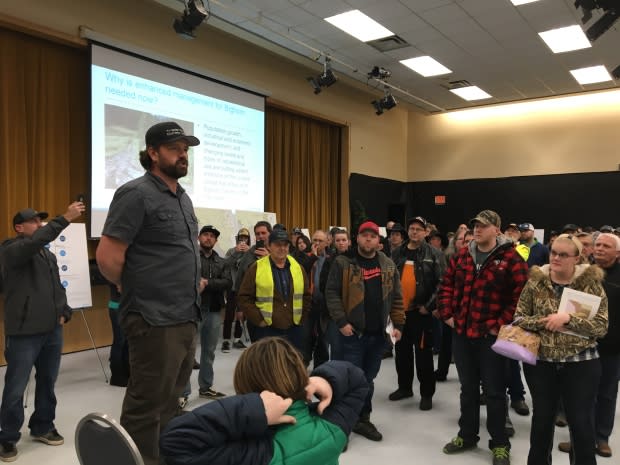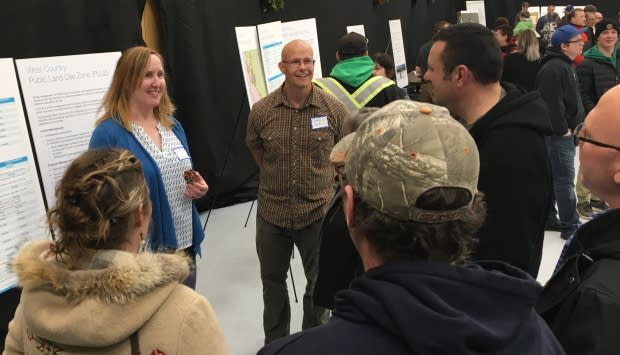Bighorn parks proposal gets cool reception in Rocky Mountain House
The government's proposal to create new provincial parks in the Bighorn Country area received a cool reception at an open house in Rocky Mountain House this week.
When the proposal was released in late November, Premier Rachel Notley compared the idea to the creation of Kananaskis Country 30 years ago. But many local people are concerned the new designations would change the ways they use land that is practically in their backyards
Frustrations came to a head Monday when Ryan Brown, a construction company owner from Bentley, jumped on a chair and shouted questions to the crowd of people milling about the displays set up around the perimeter of the room.
"Who is opposed to this park the way it currently stands?" he said. "Who in this room has felt like they have not been provided with ample consultation on this process?"
The crowd appeared to overwhelmingly agree with Brown. When he asked if anyone was in favour, the room went silent.
The proposal would create four provincial parks, four provincial recreation areas and a new public-land-use zone in the area, which covers the eastern slopes of the Rocky Mountains west of Nordegg.
The area is currently managed under six public-land-use zones. Changing the designation would keep new oil and gas development, mining and forestry out of the backcountry and preserve habitat.
Off-highway vehicle (OHV) users are worried the government will bar them from using the trails that have been developed and maintained by local groups.
The government said the proposal would maintain all designated trails. But people at the Rocky Mountain House session said OHV groups were told the same thing in southern Alberta, when the government created Castle Provincial Park and Castle Wildland Provincial Park, west of Pincher Creek.
The government decided to phase out existing OHV trails in the area after hearing evidence from scientists about impacts on the environment, particularly stream crossings.
Environment Minister Shannon Phillips said the Bighorn case is different from what happened in Castle.
"In the Bighorn, you've had local stewardship groups on the ground doing responsible recreation planning, and as much as they could on their own without government really helping them for a long time," she said. "You have an absolutely different landscape out there."
'I don't trust this'
But several people at the Rocky Mountain House information session said they don't trust Phillips or the government.
"Why should we?" said Sylvan Lake resident Rod English. "Look at the example in Castle. They pulled exactly the same stunt."
"I don't want this. I don't trust this," said Red Deer OHV rider Seamus Willox.
"The vagueness of it. The lies that we've seen in the past. The restriction of letting us come to proper consultations, because this is not a proper consultation."
Not everyone was opposed to the project.

Marguerite Berkhout expressed mixed feelings about the government plan.
"I certainly like the proposals in terms of enhanced recreation and tourism, better facilities, more trails," she said. "I'm just not sure if if it needs to become a park. Could lead to more restrictions and closures."
Laura Henning said she liked that the government plans to invest in staging facilities, and add fire rings and outhouses in popular random camping areas.
Henning hikes, camps and rides her quad in the backcountry. She doesn't share concerns that the government plans to cut OHV users out of the area.
"What I'm hearing and what I'm seeing is that it's not doing that," she said. "That they just want to invest in what the local volunteer groups are already doing out in the areas."
The public consultation period is underway until the end of January. The government is gathering input through an online survey, telephone town halls and closed-door consultations with stakeholders.
Open houses are being held in Rocky Mountain House, Sundre, Red Deer, Drayton Valley and Edmonton, where people can look at maps and ask government staff questions.
About 550 people attended Monday's session in Rocky Mountain House.
'They won't talk to us'
Some people were frustrated with the open house format. They wanted Phillips to come to the community and take questions.
"The government doesn't understand the area like the general population that lives there and uses this area," Brown said. "But they won't talk to any of us."
A total of 727 people attended the two open houses in Rocky Mountain House. About 22,000 people listened in on a telephone town hall with Phillips last week.
The province wants to spend $40 million over five years to create the infrastructure for backcountry and front-country camping, hiking, paddling, snowmobile and off-highway vehicle use.

Under the proposal, David Thompson, North Saskatchewan River and Ya Ha Tinda Provincial Parks would have trails for hiking and horseback riding, and staging areas for kayaks and canoes.
David Thompson and Ya Ha Tinda would have spots for RV and car campers.
The Snow Creek, Bighorn Dam and Hummingbird Provincial Recreation Areas would have designated trails and staging areas for off-road vehicles.
The Bighorn Wildland Provincial Park would preserve large swaths of the region that borders Jasper and Banff National Parks. It would be open to backcountry campers, hunters and fishers.

